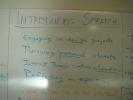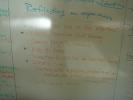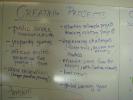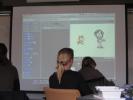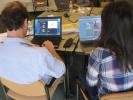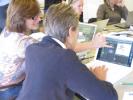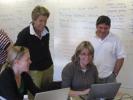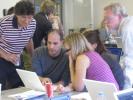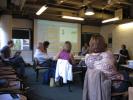Helping People Get Started with Scratch
On Saturday, September 26, Mitch Resnick and I hosted a workshop with 16 Scratch educators, who came to the workshop with a wide range of backgrounds and experiences. The focus of the workshop was discussing strategies for introducing Scratch to young people and other educators. (Many thanks to Ingrid Gustafson, who took notes about the session and shared them via Google docs, and to Michelle Chung, who took photos during the session.
In preparation for the gathering, I developed a short guide to designing Scratch workshops. The guide describes six core elements that could be part of an introductory (or not-so-introductory) Scratch workshop: setting goals, meeting one another, introducing Scratch, creating projects, sharing experiences, and preparing for next steps. We structured our workshop to match these elements, shifting perspectives between experiencing the workshop and talking about our experiences of the workshop.
We began by setting three goals for the workshop: (1) discussing approaches and techniques for getting started with Scratch, (2) developing (and engaging in) hands-on experiences with Scratch, and (3) using ScratchEd to document our experiences. I think we did fairly well on the first two goals, but not very well on the third. It's always challenging to make the time to document what happens in a workshop!
Next, we went around the room and introduced ourselves. Some people were new to Scratch; many had already been helping others learn Scratch. Most were K-8 technology teachers or coordinators.
Mitch and I then talked about four principles that we believe are key for designing successful Scratch workshops:
- Participants should have opportunities to engage in design activities. Get people actively involved by imagining, designing, and creating their own projects.
- Participants should have opportunities to pursue personal interests. At the end of the workshop, all of the projects should not look identical. Through activity design, give people the space to explore ideas that excite them.
- Participants should have opportunities to interact through creative collaborations. Computers are inherently one-to-one experiences. Mix people up in different configurations. What about working in pairs? Or passing computers between people?
- Participants should have opportunities to reflect on experiences. Create opportunities for participants to think about their experiences and their thinking about it. What worked? What didn’t? What did the experiences mean to them?
After we provided this overarching framework for thinking about Scratch workshop design, we shared strategies for introducing Scratch. Numerous approaches were suggested:
- demonstrating the mechanism of snapping blocks together
- asking participants what they notice about the user interface
- tinkering with the most readable sample projects
- putting out Scratch cards
- showing the videos from the Scratch website
- starting with problem or interest, rather than Scratch itself
Through this process, we discussed the different elements that people thought were important to demonstrate: snapping blocks together, help screens, x/y axes, sprites vs. costumes, green flag, key press, movement, sound.
After the Scratch introduction, we talked about giving participants opportunities for hands-on activities and different possibilities for projects. In addition to the suggestions in the guide (8 blocks, monkey business, interactive us, pass it on, interactive postcard, let's play), the workshop participants talked about different projects they've tried, including different topics (public service announcements, global warming, african myths) and different formats (jeopardy games, remixing sample projects, book reports, quizzes). These different approaches raised several tensions about participants' autonomy: how do we balance constraints with inspiration, structure with freedom?
After the discussion about how we might design hands-on activities, we dove in and engaged in a hands-on activity -- the pass-it-on activity where participants collectively construct stories by starting a story with Scratch and then passing it on. We then shared our experiences with the activity. Participants talked about how the pass-it-on process enabled learning from neighbors and building on others' experiences, provided opportunities for building confidence, created a community-oriented support network that accommodated different learning styles, as well as fostered unexpected moments. We concluded the workshop by discussing what to do after workshops, including ScratchEd, future events, and extensions to Scratch (like the Scratch sensor board and LEGO WeDo robotics kit).
It was an interesting and lively afternoon, giving me many ideas for ways I could remix and reimagine the workshop guide. I hope that you'll share your thoughts about and suggestions for the workshop guide -- and that you'll be able to join us for future events!



